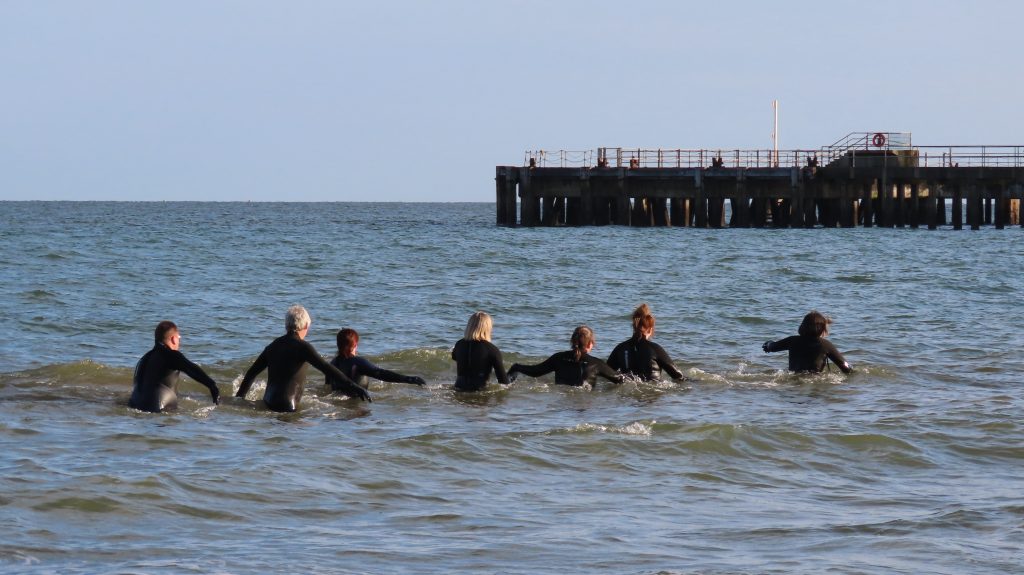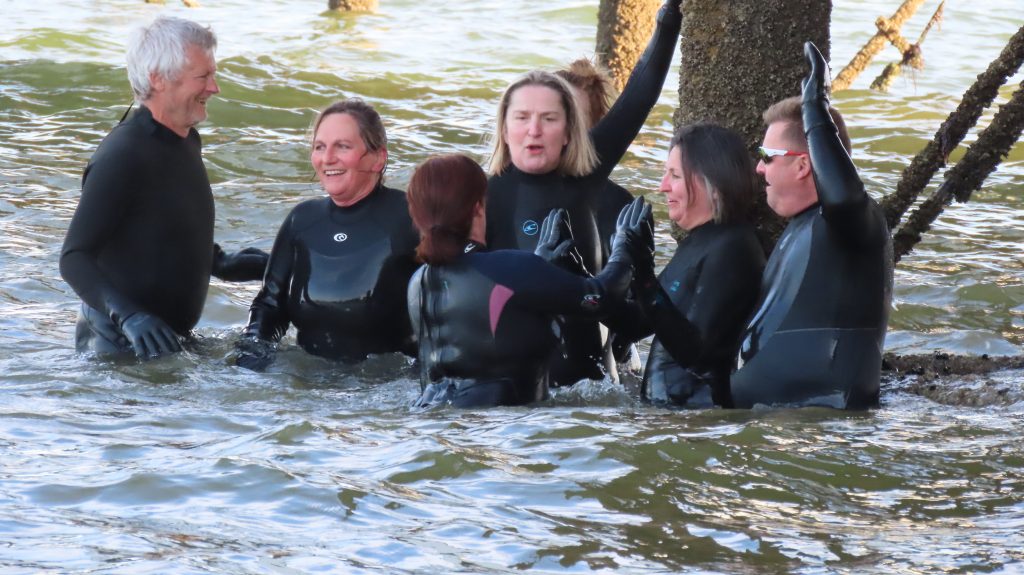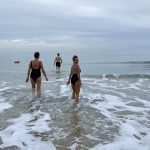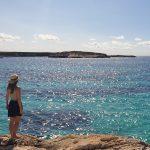
Sea hiking: A step towards sea swimming
Sea hiking could be a stepping stone into sea swimming for those who are not yet confident. Both energetic and relaxing, competitive, yet social – it appeals to both swimmers and non-swimmers as Sandy Ciccognani explains
Sea hiking, also known as Aquatic Walking or Longe-cote, is a great activity for open water swimmers who want to spend more time in the water, work on muscle building, focus on endurance in winter or when conditions are not ideal for swimming.
Essentially, it is walking through the sea, parallel to the shore, with the water between waist and chest height, using a forward lunging motion. Arms, with the optional addition of hand or short paddles, are used to maintain balance and to pull yourself through the water. It is usually done in a conga-like formation with hikers taking it in turns to lead from the front and the others drafting behind.
It was started in 2005 by rowing coach Thomas Wallyn, who wanted to develop a form of muscle training that would not cause too much strain on the joints. He never expected it would become so popular. News spread beyond the rowing community and there are now over 400 established clubs in France and others across Europe. Decathlon even has its own range of specialist “sea walking” equipment. It is popular with all ages and many extolling the health benefits.
The resistance of the water means that it is far more effective at improving fitness than walking on land and the added bonus of exposure to cold water is stimulating to the circulatory and immune systems. It uses all the major muscle groups in the body and particularly builds strength in the back and shoulders when paddles are used.
The low impact nature of the activity means it can also be good for recuperation after injury. The fact that you are in the sea, in contact with the water and close to other people means that you benefit from both nature and the social element. It is also great for making spectators stop in their tracks, trying to figure out what on earth you are doing, so ideal for anyone with slightly anarchic tendencies.
Keeping your feet firmly on the seabed
We discovered this water sport when tandem touring in Brittany last summer. The sight of long lines of people walking in waist high water in fluorescent t-shirts was both intriguing and enticing. We knew instantly that it was something we had to try at home. I put a call out to friends on the Isle of Wight, saying I wanted someone to test it out and we soon had a core group willing to go out in the wind and rain and work out how and where to do it. We made a few TikTok videos, started a Facebook page and with minimal effort we now have over 100 members (although not all have actually tried it yet). There are plans to hold our first competition later in the year too.
During our first winter, we gathered as a group of between three and twelve people at a time. We tend to go out for half an hour at a time, covering about 1.2km, followed by some socialising on the beach or local bar. Unlike wild swimming, it seems to appeal as much to men as it does to women. Perhaps it is the competitive element, the race to the pier or the fact that being stronger helps more than having perfect technique. Who knows and who cares, for me what is important is that sea hiking has the potential to get more people interested in the sea and, in the long term, interested in sea swimming.


Those who are not confident swimmers can take comfort in keeping their feet firmly on the seabed and staying within arm’s reach of others throughout the activity. When the sea is choppy, you have the choice of remaining around waist depth and enjoying a series of jumps and submersions or walking in shallower waters, which can still be remarkably hard work, especially if you are walking against a strong tide.
The Isle of Wight has Biosphere status and is recognised for the significance of its rich landscape, coasts, biodiversity, and heritage. Sandown Bay is the perfect place to experiment with this sport as it can be done whatever the tide and has miles of uninterrupted sand. Sea hiking is another way to encourage links between people and the natural environment, helping those involved to have a better understanding of the coastal environment and vested interest in its protection.
Since sea hiking and being in the sea without my head in the water, I have become more aware of what is going on around me: the noises, the birds and ever-changing shifting of the sands. Don’t get me wrong though, I still love swimming and it will forever be my favourite sport. I always want to swim after a sea hike, usually pulling off the wetsuit and shoes as soon as we get back to the starting point. Personally, I need to feel the water on my skin and in my hair before I get out.
As far as I know, the only other group in the country is Longe-cote UK in Falmouth. We’d love to hear from anyone elsewhere in the country who gives it a go and if you are visiting the Isle of Wight this summer, get in touch! I suspect that as the water warms up, the enthusiasm and consequent numbers of sea hikers here will swell.
Photos: Bruce Webb
To see all the online content from the June 2023 issue of Outdoor Swimmer, visit the 'Sea' page.







